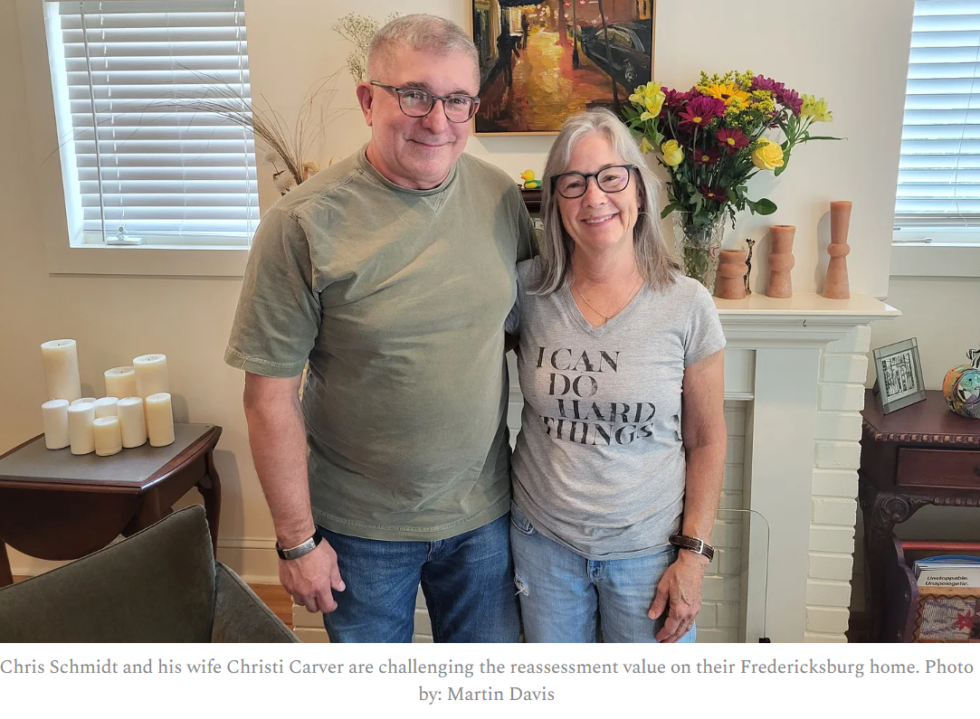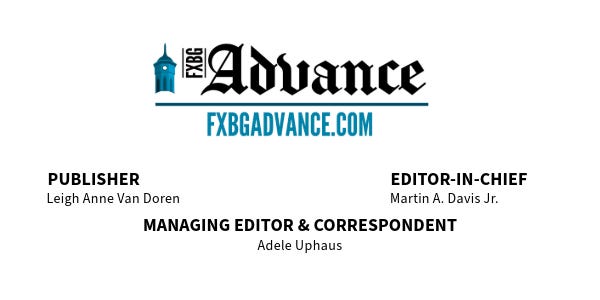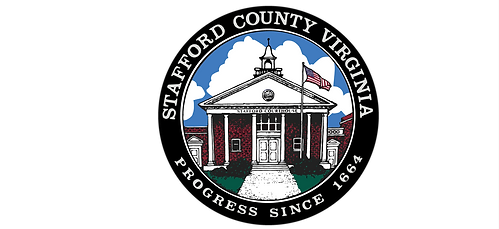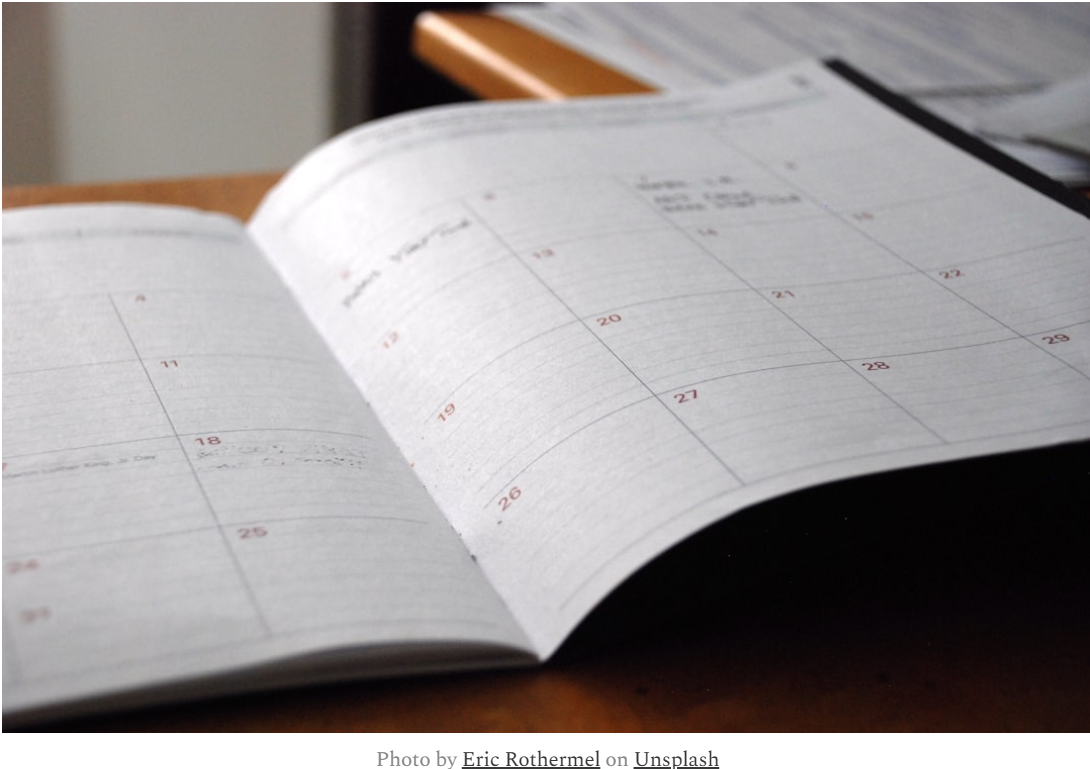
Fredericksburg residents this year received significantly higher property valuations. Those who wish to challenge must confront both objective and subjective estimates.
One wouldn’t think there’s much connection between Downtown Greens and residential real-estate tax assessments, but to Chris Schmidt of Fredericksburg, the controversy over the former led to asking a series of probing questions about the latter.
“I was curious to learn more about the details … surrounding the purchase of property in the Industrial Park by Downtown Greens a couple years ago,” he told the Advance. And from that, he began “to look at property records, assessments, and talk with members of the City staff and [the Economic Development Authority].”
What started as a curiosity led Schmidt and his wife, Christi Carver, to challenge the assessment leveled on their home this year. His petition to have the valuation changed was rejected, and he now is preparing to appeal to the Board of Equalization this month.
That challenge, however, comes with a problem that Schmidt and many other homeowners in the city of Fredericksburg face — especially those who inhabit homes that assessors refer to as “nonhomogeneous.” That is, homes that are built not as part of a neighborhood or subdivision where the houses present little variance in style (i.e., “homogeneous homes”), but rather homes that are of historic value, are custom builds, or have undergone extensive renovations.
Subscribed
Home values are based on objective and subjective elements. If you live in a neighborhood of similar-style homes and add a deck proximate in size and materials to your neighbors’ decks, one can relatively easily and objectively arrive at its value.
When one’s home has a number of sui generis elements, however, how does one decide the proper value? Factors like “curb appeal” or “desirability” due to location are more subjective and can lead to significant differences of opinion as to a property’s value.
Homeowners in nonhomogeneous homes wishing to challenge assessments they find too high can have a more challenging time because there is little to compare their property with.
Spreadsheets, Spreadsheets, Spreadsheets
Schmidt began by talking with his neighbors, and from those conversations suspected that something was not lining up with the assessments leveled on properties in his community. So he turned to data to test his hypothesis.
Using the city’s GIS maps and publicly available data on reassessments, Schmidt created a sophisticated spreadsheet and began to compare his property with that of his neighbors. What he found was a significant variation in the amounts that land values were assessed at.
Schmidt’s home sits on just 0.11 acre of land and was assessed at $200,000 four years ago, which works out to just over $1.7 million per acre. The new assessment raised the value to $350,000, or just over $3 million per acre — a 75% increase.
But move up and down the street, and that level of increase in land values was not always reflected. Some homes saw their land values rise just 9%. Another was 27%, and a couple came in at the 40% – 50% range.
This didn’t make sense to Schmidt, who told the Advance that “land is immutable,” so why wouldn’t these values be more consistent?
Scott Mayausky is Commissioner of the Revenue in Stafford County and not unfamiliar with the frustrations homeowners have over their real-estate assessments — a big part of his job is listening to people with complaints.
Oftentimes, these complainants come armed with spreadsheets like Schmidt’s that compare property values with their neighbors’ and similar-type properties.
And like Schmidt, they’re befuddled at the fluctuations they see. The reality, Mayausky tells the Advance, is that “land values per square foot are all over the place.” And there are good reasons that this is the case.
Mayausky notes that “The per square foot price of a residential building lot is irrelevant because that is not how building lots sell. The value of residential land is based on utility not necessary size.”
For example, he continues, “in the real estate market there is no practical difference between a 4,000 and 6,000 square foot lot because they have the same utility, they both support one house.”
Mayausky notes that the first time a property sells, it is sometimes done at a premium that the developer sets — cul-de-sac property, for example, will carry a premium over non-cul-de-sac properties.
“The resale of that property won’t reflect any of that [markup] because the market doesn’t function that way,” Mayausky told the Advance. “What appraisal is supposed to do is determine the resale value, not the first time it sold (Lot premiums are not market value).”
The problem becomes magnified when one is talking about assessing properties that are one-offs, or exist in neighborhoods with a variety of styles, as in Fredericksburg (and Schmidt’s neighborhood) where historic buildings and new buildings or new add-ons frequently exist side-by-side.
Mayausky acknowledges that issue.
“Each historic home in Fredericksburg is unique to itself,” he said.
And for this reason, the disagreements over reassessment values begins to fall more on subjective elements. The challenge of assessors is mitigating how much impact subjectivity plays in their decision-making.
The Test of Reasonableness
While Stafford County handles its reassessments in-house, Fredericksburg outsources this work to a third-party source — Wingate Appraisal Service.
Based in Roanoke, Virginia, Wingate takes a wide range of factors into play when assessing values. These include public records, tax records, multiple listing services, online tools like satellite and street imagery, and appraisers’ files.
The Advance did not speak directly with Wingate; however, Fredericksburg’s assistant city manager, Mark Whitley, shared our questions via email with Don Thomas of Wingate.
Asked specifically how subjectivity is mitigated in the case of a nonhomogeneous property, Thomas replied:
In nonhomogeneous property samplings or neighborhoods, differences in relative desirability from one property to another come down to the test of reasonableness, as market responses can vary and cannot be quantified by mathematical forumlas.
And it is this level of subjectivity that is frustrating to people like Schmidt.
Over a stretch of real estate that is among the most-desirable in the city, how does one reasonably distinguish one piece of property’s land being more “desirable” than another’s?
According to Thomas, “subjective observations are the appraiser’s perspective gained from experience and familiarity with a particular occupancy in a specified real estate market.”
All about the Process
Mark Whitley acknowledges that the subjectivity question is a challenging one. He also notes, however, that the city offers an appeals process.
Appeals occur in two rounds.
The first appeal involves a property owner communicating with Wingate and making their case.
That process, which is already completed, included 317 appeals — or 3.4% of the city’s 9,224 parcels — this year; 166 of those resulted in adjustments.
“Not every adjustment resulted in lower taxes,” Whitley said. Sometimes, the assessor realizes they erred on the low side and have to adjust the total up. But overall, the first round of appeals resulted in a net total decrease of $34,562,000, according to a memorandum from Whitley to city manager Tim Baroody, dated September 11, 2024.
Even with those adjustments, however, the impact of the city’s growth, tightening housing market, and inflationary pressures has raised property values significant.
In Whitley’s memorandum to Baroody, for example, he notes that “Class 1” single-family residential properties are up some 30% over the last assessment four years ago. Those properties have jumped from a total of $2,426,974,000 in 2021 to $3,156,180,400 today.
Four of the other five categories (single-family suburban, multifamily residential, commercial and industrial, and agricultural 20-99 acres) also recognized jumps in valuation. Only agricultural properties over 99 acres showed 0% growth in valuation.
The second round of appeals is currently underway and involves citizens taking their case to the Board of Equalization.
This board is composed of three individuals who have undergone training by the Virginia Department of Taxation.
The Schmidts will take their case to the board later this month. Again, the onus will be on them to make their case that their land value has been set too high.
How best to do that?
According to Mayausky, owners need to bring the best evidence they can to make their case for fair market value. At that point, it’s up to the review committees to
1. Determine fair market value
2. Be equitable
“If you can’t achieve both,” Mayausky says, “equity should take precedence.”
How to Appeal Your Assessment
Fredericksburg residents have until October 15 to file an appeal with the Board of Equalization.
The first appeals were heard October 7. The remaining dates to hear appeals are as follows:
- Thursday, November 7, 2024 from 9am-12pm in City Hall, Rm 202
- Thursday, November 21, 2024 from 4pm-7pm in City Hall, Rm 200
- Monday, December 2, 2024 from 9am-12pm in City Hall, Rm 202
- Thursday, December 5, 2024 from 9am-12pm in City Hall, Rm 202
For more information, consult the Board of Equalization’s website.




Local Obituaries
To view local obituaries or to send a note to family and loved ones, please visit our website at the link that follows.

Support Award-winning, Locally Focused Journalism

The FXBG Advance cuts through the talking points to deliver both incisive and informative news about the issues, people, and organizations that daily affect your life. And we do it in a multi-partisan format that has no equal in this region. Over the past month, our reporting was:
$8 a month supports great journalism
- First to report on a Spotsylvania School teacher arrested for bringing drugs onto campus.
- First to report on new facility fees leveled by MWHC on patient bills.
- First to detail controversial traffic numbers submitted by Stafford staff on the Buc-ee’s project
- Provided extensive coverage of the cellphone bans that are sweeping local school districts.
- And so much more, like Clay Jones, Drew Gallagher, Hank Silverberg, and more.
For just $8 a month, you can help support top-flight journalism that puts people over policies.
Your contributions 100% support our journalists.
Help us as we continue to grow!
Support FXBG Advance for $8 a month







